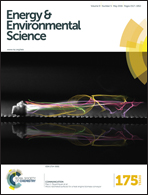An ethylenediamine-grafted Y zeolite: a highly regenerable carbon dioxide adsorbent via temperature swing adsorption without urea formation†
Abstract
Solid adsorbents including amine-functionalized porous materials and zeolites have been extensively investigated for post-combustion CO2 capture. Amine-functionalized porous materials have shown highly promising CO2 uptake in a wet flue gas, but suffer from significant amine deactivation due to urea formation under desorption conditions (e.g., desorption under 100% CO2 at >130 °C) of temperature swing adsorption (TSA) cycles. In contrast, purely inorganic zeolites are thermochemically stable but cannot adsorb CO2 from a wet flue gas because of the preferential H2O adsorption. In the present work, we synthesized an ethylenediamine-grafted Y zeolite, which can synergistically combine the strengths of both adsorbent systems. The amine groups can effectively capture CO2 in a wet flue gas, while the strongly co-adsorbed H2O within the hydrophilic zeolite micropores suppresses urea formation (dehydration reaction between amines and CO2) under desorption conditions according to Le Chatelier's principle. The organic–zeolite hybrid adsorbent retains working capacities higher than 1.1 mmol g−1 over 20 TSA cycles. Because the adsorbent is prepared from a commercially available zeolite, it is also highly cost efficient and suitable for mass production.


 Please wait while we load your content...
Please wait while we load your content...